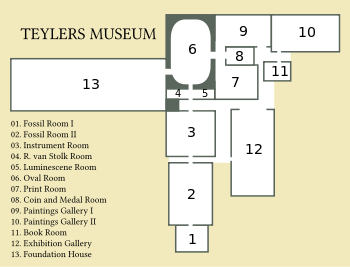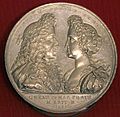
The Frans Hals Museum is a museum located in Haarlem, the Netherlands.

Martin(us) van Marum was a Dutch physician, inventor, scientist and teacher, who studied medicine and philosophy in Groningen. Van Marum introduced modern chemistry in the Netherlands after the theories of Lavoisier, and several scientific applications for general use. He became famous for his demonstrations with instruments, most notable the Large electricity machine, to show statical electricity and chemical experiments while curator for the Teylers Museum.
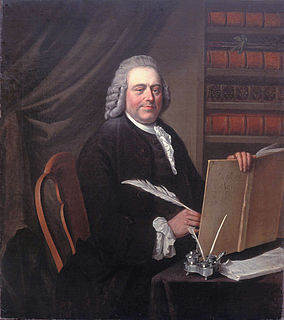
Pieter Teyler van der Hulst was a wealthy Dutch Mennonite merchant and banker, who died childless, leaving a legacy of two million florins to the pursuit of religion, arts and science in his hometown, that led to the formation of Teyler's Museum. This was not the value of his entire estate. He also founded Teylers Hofje in his name, and made important donations to individuals in the Mennonite community.

Wybrand Hendriks, was a Dutch painter and the concierge of the Teylers Museum. He is primarily known because of his portraits.

The Oval Room in the Teylers Museum was the first part of the museum that was opened in 1784. It could be entered through the garden of the fundatiehuis, the former home of Pieter Teyler van der Hulst. The building has an oval shape built around its centerpiece, a mineralogical cabinet. The Oval Room consists of two floors; the ground floor with its display cabinets and a gallery of books that connects to the Teylers Library. On top of the room, on the roof, the astronomical observatory used to be a landmark that could be seen for miles along the river Spaarne. The gallery and observatory are longer accessible to the public, though the gallery can be seen from the ground floor.

The Fundatiehuis is the former family home of Pieter Teyler van der Hulst on the Damstraat 21 in Haarlem, Netherlands. After his death it became the seat of the Teylers Stichting and through its front door, visitors could reach the Oval room.

Jacobus Barnaart was a Dutch merchant and one of the five first directors of the Teylers Stichting.

The Teylers astronomical observatory is an astronomical observatory built in 1784 on the roof of the Oval Room of the Teylers Museum in Haarlem.

Johann Georg Holtzhey, was an 18th-century Dutch medallist and mint master.
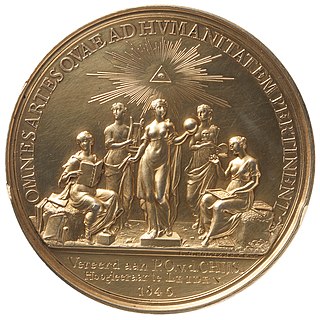
Teylers Tweede Genootschap, also known as the Wetenschappelijk Genootschap is one of the two societies founded within the Teylers Stichting with the purpose to promote and award prizes for research. They were the result of the testament of the Dutch 18th-century merchant Pieter Teyler van der Hulst. The Second Society is focused on art and science, while the First Society is focused on theology.
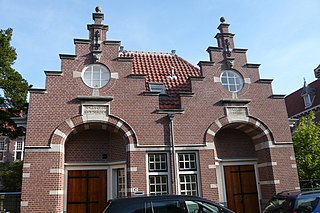
The Coen Cuserhof is a former orphanage in Haarlem. The complex was designed by J.A.G. van der Steur and the original maquette is on display in the Historisch Museum Haarlem.

Cornelis van Noorde, was an 18th-century landscape painter and draughtsman from the Northern Netherlands.

The Top of the Mont Blanc is an appropriately named collection piece on display in the Oval Room of Teylers Museum. The specimen was cut off from the highest findable piece of exposed rock of the Rocher de la Tournette high on the snow covered summit ridge of the Mont Blanc on 3 August 1787, during one of the first climbs of the mountain by the Swiss scientific pioneer Horace-Bénédict de Saussure.

The Eerste Schilderijenzaal, or Painting Gallery I, is one of two art gallery rooms in Teylers Museum and is the oldest art gallery for contemporary Dutch art in the Netherlands. It was built onto the back of Teylers Oval Room in 1838. It was the young museum's first exhibition space for paintings and could be entered through the Oval Room, which was itself located behind the Fundatiehuis, the former home of Pieter Teyler van der Hulst.

The Tweede Schilderijenzaal, or Painting Gallery II, is one of two art gallery rooms in Teylers Museum. The Tweede Schilderijenzaal was built in 1893 as an extension of the first gallery.

The Instrument Room is a room in Teylers Museum which houses a part of the museum's Cabinet of Physics: a collection of scientific instruments from the 18th and 19th centuries. The instruments in the collection were used for research as well as for educational public demonstrations. Most of them are demonstration models that illustrate various aspects of electricity, acoustics, light, magnetism, thermodynamics, and weights and measures. The rest are high-quality precision instruments that were used for research.

The Fossil room II is one of two paleontological display rooms in Teylers Museum. The Fossil room II was built in 1885 as an extension of the first Fossil room I, under the direction of the architect Ad van der Steur Jr..


